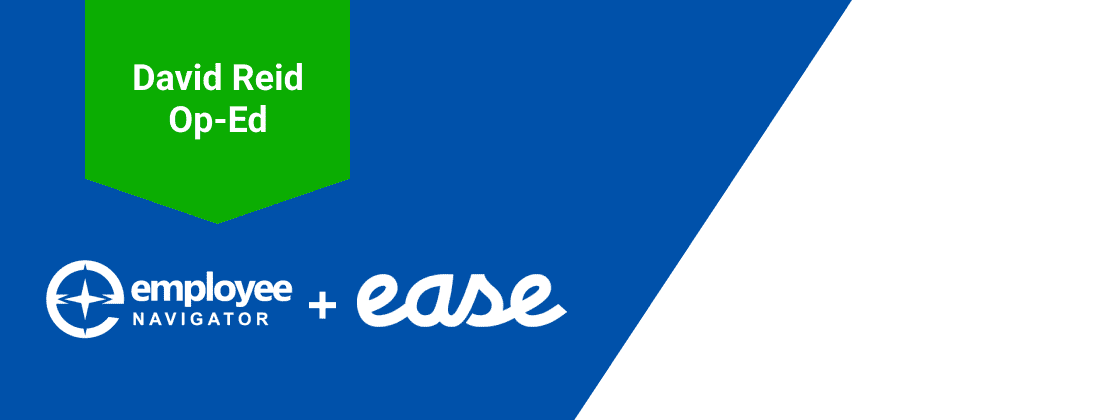
Greetings,
It’s hard to believe nearly five months have passed since Employee Navigator acquired Ease. It has been exciting to see the pace at which the organizations are being combined, processes are being streamlined and, most importantly, the emergence of a unified, best-in-class, broker driven solution setting new industry standards. When the announcement was made I said, “All are in good hands with George Reese at the Helm”. I’m happy to report that I can unequivocally say the same today. I believe George’s vision and operational road map will enable all to accelerate, compete, and provide true ‘value add’ that only a Digital Broker can provide.
As we move forward together, I wanted to address the rationale for why certain decisions are being made that are causing heartache for some long-time Ease users and why these moves are in the best long-term interest of the insurance industry. A core value that George Reese and I share is building the best solution to enable access to quality healthcare for all. Brokers play a critical role in this mission.
An ‘agnostic’ solution is core to our strategy. I used to refer to this as ‘pure play’, meaning you, as the broker, can use virtually any product that best meets your customers’ needs. This capability, combined with your client relationship, product knowledge, and industry expertise, puts you in a more competitive position than a national payroll vendor or highly funded Silicon Valley start-up, intent on displacing traditional brokers.
The stakes are high, but the rewards are even higher for those who embrace all that is required in 2023 and beyond. You will see popular elements of Ease incorporated into the combined platform, but you will also see Employee Navigator’s best practices replacing some of my strategies deployed at Ease. This is coming quickly and will require adaptation for some.
Carrier connection standards. Data integrity, essential for what we do, requires consistency and standardization. We can’t build hundreds of different carrier specifications. At Ease, we tried to be very flexible to accommodate legacy carrier systems, but this proved difficult as we added new partners. One of the attractions to becoming part of Employee Navigator is they have established an industry standard that is already accepted by many leading carriers. We will be converting to this standard.
Stakeholder roles. Benefit administration regularly requires someone to address errors and discrepancies. For example, a birthdate, address, or social security number in the Benefit Administration System doesn’t match the birthdate at a carrier. Resolving discrepancies like this is a common practice and the stakeholder closest to the data discrepancy is the one that should resolve the discrepancy.
In most instances, this is the group administrator. At Ease, we attempted to play an active role in addressing discrepancies but agree with Employee Navigator that this is not sustainable at the scale we have reached across 70,000+ companies on Ease.
We have built and will continue to build tools, based on your feedback, that make this process as efficient as possible, but these are ‘tools’. These tools can be used by you, your employers, and other stakeholders such as enrollment partners and General Agents. This naturally belongs with brokers and HR.
Connection costs. Insurance carriers have hired thousands of employees to manually enter enrollment data and account for these costs in their premiums. While building and maintaining a secure, world-class benefit administration platform costs money, it provides a significant return on investment for the carriers by bringing them greater efficiency and accuracy. Benefits administration technology also drives additional sales to carriers when our platform is being used versus a paper-based or highly fragmented solution of multiple, antiquated carrier portals.
Forward thinking carriers recognize this and are supporting the technology by using a portion of these gains to pay those providing the automation and providing Digital Brokers with technology credits. Whenever possible, we encourage you to support the forward-thinking carriers that recognize they are a beneficiary of a technology-enabled broker solution.
Staying ‘front and center’. There have been many efforts to displace the broker dating back to the early 90’s, followed by Obamacare in the 2000’s and most recently Direct to Employer entities that use Payroll and HR to ultimately displace you, the broker. Having been in this industry for 35 years I have observed a trend. The more they try to get rid of us, the more we are needed.
Employee Navigator, combined with Ease, provides the largest employer-centric platform for employers that squarely and solidly puts you, the broker, in full control of your accounts.
Partners. I have always said that our industry relies, more than any, on partnerships. Our platform was designed to facilitate partnerships with General Agents and Enrollment firms that you already work with. While some brokers choose to manage all elements of enrollment themselves, we have seen many successful partnerships between our brokers and these value-add partners.
If you would like to learn more about how these partners can work with you, please reach out to me any time.
In this difficult world of health insurance, brokers are the answer. You bring true value to your employers, their employees, and families. When you combine your client relationships and expertise with a fully digitized environment controlled by you. . .you become irreplaceable. That said, good things require dedication.
Upon reflecting about Employee Navigator and Ease, the two platforms are very similar and Employee Navigator will have no problem adding some of Ease’s features to their platform. The real difference is Employee Navigator anticipated the need to scale early on. Ease tried to provide “white glove” service to brokers which proved to be unscalable, and Employee Navigator built a system that allows brokers to provide “white glove” service to their customers.
In the upcoming months I welcome conversations around these topics and want to be helpful to brokers with the transition ahead. I ask that you embrace these changes and promise you the rewards will be significant. I am as confident as ever that George has the best interest of the industry in mind.
David Reid


